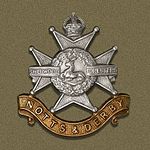- Sherwood Foresters
-
The Sherwood Foresters (Nottinghamshire and Derbyshire Regiment) 
Badge of the Sherwood ForestersActive 1881–1970 Country  United Kingdom
United KingdomBranch  British Army
British ArmyType Infantry Role Line Infantry Size Two battalions Anniversaries Badajoz (6th April)
Alma (20th September)The Sherwood Foresters (Nottinghamshire and Derbyshire Regiment) was formed during the Childers Reforms in 1881 from the amalgamation of the 45th (Nottinghamshire) Regiment of Foot and the 95th (Derbyshire) Regiment of Foot. The new regiment also included the militia and rifle volunteer units of Nottinghamshire and Derbyshire.
Following a series of mergers since 1970, its lineage is today continued by the 2nd battalion, the Mercian Regiment.
Contents
Formation
The regiment was formed as part of the reorganisation of the infantry by the Childers reforms. The 45th (Nottinghamshire) Regiment of Foot (raised in 1741) and the 95th (Derbyshire) Regiment of Foot (raised in 1823) were redesignated as the 1st and 2nd battalions of The Sherwood Foresters (Derbyshire Regiment), while the Derbyshire and the Royal Sherwood Foresters Militias became the 3rd and 4th Battalions respectively. These were joined by the 1st and 2nd (Derbyshire) and 3rd and 4th (Nottinghamshire) Volunteer Battalions. In 1902 the Nottinghamshire association was made explicit, the name changing to The Sherwood Foresters (Nottingham and Derbyshire) Regiment. The Headquarters of the Regimental District was established at Derby.
Service history
Following amalgamation the Sherwood Foresters saw action in Egypt in 1882 and in South Africa during the Boer War.
During the First World War the Sherwood Foresters raised 33 battalions, of which 20 served overseas. This was mainly on the Western Front, but also in Gallipoli, Italy, and the Middle East. Over 140 ,000 men served in the regiment, which lost 11,400 killed. The regiment won 57 battle honours, and 2000 decorations, including 9 VCs.
After garrison service in the interwar years the Sherwood Foresters again saw action, in the Second World War. The regiment served in the Norwegian Campaign and the Battle of France, and later in the North African and Italian campaigns. They also saw action in the Far East. Over 16 battalions were raised, and nearly 27,000 men served in the regiment, suffering 1500 killed. The regiment won 10 battle honours and won 400 decorations, including a VC.
In 1940 the 70th (YS) Battalion Sherwood Foresters were stationed at Holme Pierrepont Hall near Radcliffe on Trent Nottingham. The young soldiers battalions were formed to take volunteers who had not reached the compulsory age of conscription.[1]
In post war period Sherwood Foresters served as occupation forces in Germany, and later in the BAOR. In 1958 they saw action in Malaya and, in 1963, in Cyprus.
Alliances
In 1931, the Sherwood Foresters were officially allied with the Simcoe Foresters (35th Regiment of Infantry), Canadian Militia. This alliance has continued to the present day through The Worcestershire and Sherwood Foresters Regiment (29th/45th Foot) and the Mercian Regiment with The Grey and Simcoe Foresters.
Amalgamation
In 1970 the Sherwood Foresters were amalgamated with The Worcestershire Regiment to form The Worcestershire and Sherwood Foresters Regiment (29th/45th Foot).
Battle honours
- post 1881:
- Egypt (1882), Tirah, South Africa 1899–1902
- World War I:
- Aisne 1914 & 18, Armentieres 1914, Neuve Chappelle, Aubers, Hooge 1915, Loos, Somme 1916 & 18, Albert 1916 & 18, Bazentin, Delville Wood, Pozieres, Ginchy, Flers-Courcelette, Morval, Thiepval, Le Transloy, Ancre Heights, Ancre 1916, Arras 1917 & 18, Vimy 1917, Scarpe 1917 & 18, Messines 1917, Ypres 1917 & 18, Pilckem, Langemarck 1917, Menin Road, Polygon Wood, Broodseinde, Poelcappelle, Passchendaele, Cambrai 1917 & 18, St Quentin, Baupaume 1917, Rosieres, Villers Brettaneux, Lys, Bailleul, Kemmel, Scherpenberg, Amiens, Drocourt-Queant, Hindenburg Line, Epehy, Canal du Nord, St Quentin Canal, Beaurevoir, Courtrai, Selle, Sambre, France & Flanders 1914 - 18,
- Piavé, Italy 1917 - 18,
- Suvla, Landing at Suvla, Schimitar Hill, Gallipoli 1915,
- Egypt 1916
- World War II:
- Norway 1940,
- St Omer-La Bassee, Ypres-Comines Canal, Dunkirk 1940, North West Europe 1940,
- Gazala, El Alemain, Djebel Guerba, Tamera, Medejez Plain, Tunis, North Africa 1942 -43,
- Salerno, Volturno Crossing, Monte Camino, Anzio, Campoleone, Advance to Tiber, Gothic Line, Coriano, Cosina Canal Crossing, Monte Ceco, Italy 1943 - 45,
- Singapore Island, Malaya 1942
Victoria Crosses
The following members of the regiment were awarded the Victoria Cross:
- Private Bernard McQuirt, Indian Mutiny
- Lieutenant (later Captain) Henry Singleton Pennell, Tirah Campaign
- Private (later Corporal) William Bees, Second Boer War
- Corporal (later Captain) Harry Churchill Beet, Second Boer War
- Corporal (later Sergeant) Ernest Albert Egerton, Great War
- Acting Corporal (later Sergeant) Fred Greaves, Great War
- Captain (Temporary Lt-Col, later Major-General)) Charles Edward Hudson, Great War
- Sergeant William Henry Johnson, Great War
- Private Jacob Rivers, Great War
- Corporal James Upton, Great War
- Captain (Acting Lt-Col) Bernard William Vann, Great War
- Second Lieutenant (Temporary Captain, later Colonel) Charles Geoffrey Vickers, Great War
- Lieutenant (Temporary Captain) Albert Ball, Great War
- Lieutenant (Temporary Captain) John Henry Cound Brunt, Second World War
See also
References
External links
- British Army Regiment site[dead link]
- Regiment Crich Memorial site
- History of the Sherwood Foresters
- Captain W. C. C. Weetman M.C., Croix de Guerre. The Sherwood Foresters in the Great War 1914 - 1919, History of 1/8th Battalion at Project Gutenberg. ISBN 1436589819
Categories:- Infantry regiments of the British Army
- Regiments of the British Army in World War I
- Regiments of the British Army in World War II
- Military units and formations established in 1881
- Military units and formations disestablished in 1970
- 1881 establishments in the United Kingdom
- post 1881:
Wikimedia Foundation. 2010.
